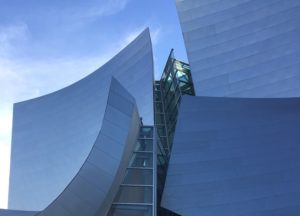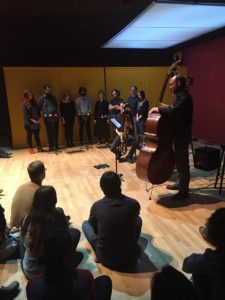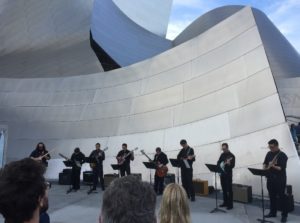 On Saturday, November 18, 2017, the Walt Disney Concert Hall in downtown Los Angeles was given over to Noon to Midnight, an entire day of performances by local new music groups. A line of taco trucks extended along Grand Avenue and a pleasantly festive atmosphere prevailed as large crowds surged in and around the facility. The centerpiece event was War of the Worlds, a new experimental opera by Annie Gosfield, conducted by Christopher Rountree and directed by Yuval Sharon. In addition, some 20 different pop-up concerts were scheduled, regrettably timed so that it was impossible to hear everything. Here are four that I managed to attend.
On Saturday, November 18, 2017, the Walt Disney Concert Hall in downtown Los Angeles was given over to Noon to Midnight, an entire day of performances by local new music groups. A line of taco trucks extended along Grand Avenue and a pleasantly festive atmosphere prevailed as large crowds surged in and around the facility. The centerpiece event was War of the Worlds, a new experimental opera by Annie Gosfield, conducted by Christopher Rountree and directed by Yuval Sharon. In addition, some 20 different pop-up concerts were scheduled, regrettably timed so that it was impossible to hear everything. Here are four that I managed to attend.
The Grand Plaza venue is a wide patio outside of Disney Hall with a brick stairway leading down to the corner of Grand Avenue and First Street. Rage Thormbones, Matt Barbier and Weston Olencki, were stationed in a somewhat sheltered corner of this space, near the glass doors leading inside. Two large speakers with a computer table completed the setup as a crowd gathered at the appointed time.
The first piece was the world premiere of For George Lewis, by Sam Pluta, commissioned by the performers. The two trombonists, equipped with special mutes connected to the computer and speaker system, began playing. At first there was some clicking and popping, and this rapidly escalated into a series of explosions and arcade-like sounds that boomed out into the open air. There was nothing heard in any sequence that sounded like an actual trombone; the mutes blocked the vibrations from exiting the horn and passed them instead to the computer. A series of foot pedals allowed each player to select various digital processing modes and the horns essentially became acoustic joysticks manipulating the output to the speakers. All sorts of electronic sounds poured from the speakers: there was the growling of an industrial buzz saw, space battle sounds, and even a series of squeaky, bird-like sounds. All of this was played with enthusiastic abandon by Barbier and Olencki who were fully committed to this novel form of trombone expression.
The volume and intensity of this piece, with it’s unexpected timbres and texture, was well-matched to the occasion and to the venue. At times it seemed as if a War of the Worlds was in progress right on the patio. Rage Thormbones battled the formidable traffic noises out on Grand Avenue, and actually prevailed. For George Lewis proved to be an intriguing adaptation of acoustic brass to real-time computer processing and the results validated both the power and the versatility inherent in this partnership.
A second world premiere, Periphery for 2, by Catherine Lamb followed. For this Barbier and Olencki used standard mutes for a more conventional trombone sound. Low, sustained tones were heard, subdued and solemn, especially so after the previous piece. A slight dissonance created a lonely, plaintive feel that continued throughout. There was a beautiful organic sensibility to this, like hearing the soft sighing of the wind in a remote canyon, and the audience was completely engaged. For the most part, Periphery for 2 was clearly audible, even in the presence of the ambient street noise. A stray car horn or the passing thump of a helicopter would occasionally intrude, but never impaired the pleasure of hearing this gently unfolding work.
The Los Angeles Electric 8 set up in an even more exposed area – down on the sidewalk at Grand Avenue and First Street. Eight electric guitarists lined up along the outside wall at the base of Disney Hall, and this did provide some acoustical support for the amplified sounds. The waiting crowd closed in, helpfully screening out some of the traffic noise, as Circle Limit III, by Daniel Corral, gracefully flowed outward in a warm ambient wash. There was no conductor, no beat or obvious pulse, and the players each kept a stopwatch to time the harmonic progressions. The piece was never static, however, with the sound rising, falling and slowly shimmering in the bright afternoon sunshine. As Circle Limit III progressed, a series of different textures arose and took hold among the players. Often this was basic strumming or slide glissandos, although occasionally a few single notes would rise to the top, nicely offsetting the rest of the sound. The harmonies were lush and comforting and worked to subvert the frenetic sounds of traffic out in the street. Circle Limit III was perfectly chosen for the sidewalk and fully captured the imagination of the crowd – listening and looking down Grand Avenue became a strangely calming and unexpectedly peaceful experience.
The guitar players of the Los Angeles Electric 8 are: Gabriel Deutsch, Nicholas Deyoe, Jeremy Kerner, Eric Kiersnowski, Andy Lee, Marc Nimoy, Felix Salazar and JohnPaul Trotter.
Soft Structures, an installation by Chris Kallmyer was presented in the BP Hall space. A length of white cloth draped down from the high ceiling, metaphorically suggesting a soft and pliable structure. This world premiere was commissioned by the LA Philharmonic and the part I heard was performed by the Southland Ensemble. The noise level in this area of Disney Hall can be distracting and Kallmyer wisely asked the gathered crowd to move in as closely as possible to the musicians. Soft Structures opened with a very low, sustained pedal tone in a double bass, soon joined by a second bass and a contrabassoon in unison. This persisted for some moments creating a beautiful, earthy pedal tone. One of the bass pitches then moved up, adding a sense of mystery. A series of bell chimes were arrayed in front of a small chorus, and at different times a sequence of high ringing tones were sounded. Soon the voices were heard, softly singing sustained tones without words. The effect of all this was a very moving, a powerful combination of the primal and the transcendental.
 Soft Structures continued in this fashion, the changes in the pedal tones, the singing and the ringing of the bell chimes was internally directed: a function of what was being played at any given time. The “score” was continuously renewed by the playing of the music itself. A large stopwatch was visible on the floor in front of the musicians, but this was only used to time the conclusion of the piece, and the thirty minutes allotted for the performance seemed scarcely enough. Soft Structures is exquisitely simple in form and structure, yet truly sublime in its result.
Soft Structures continued in this fashion, the changes in the pedal tones, the singing and the ringing of the bell chimes was internally directed: a function of what was being played at any given time. The “score” was continuously renewed by the playing of the music itself. A large stopwatch was visible on the floor in front of the musicians, but this was only used to time the conclusion of the piece, and the thirty minutes allotted for the performance seemed scarcely enough. Soft Structures is exquisitely simple in form and structure, yet truly sublime in its result.
In the main Walt Disney Concert Hall, gnarwhallaby premiered two new pieces commissioned by the LA Philharmonic. Homeostasis, by Èlise Roy was performed first, and began with a high, sustained tone in Matt Barbier’s trombone as Richard Valitutto drew a fishing line across one of the lower piano strings. A high pitch from the cello joined in, and the tutti ensemble gradually increased in volume until a loud piano crash was heard, followed by silence. The mystery deepened with a series of high, scratchy phrases in the cello. Strange sounds and extended techniques were heard among all the instruments, adding to a building sense of tension and alienation. Rapid passages predominated and were scattered without a common pulse, requiring very precise timing among the players as they made their entrances. gnarwhallaby was in top form, with crisp phrasing and good dynamic control, abetted by superior acoustics. Homeostasis was enthusiastically received by the audience as Ms. Roy joined the players on stage for a bow.
The world premiere of tkiva, by Richard Barrett, followed, and this began with very fast phrases issuing from each of the four instruments independently, unconnected by beat or pulse. The feeling was that of barely-controlled chaos, with short bursts of notes flashing outward like sparks from a raging bonfire. The tight ensemble was nimble and impressive – gnarwhallaby’s playing was consistently able to turn on a dime. There were slower, more expressive stretches – one featured a plaintive melody in the trombone with a well-matched counterpoint in the cello and clarinet. The interplay between the players during the faster sections was remarkable, especially for its timing and precision. The pace picked up even further towards the finish, with anxious trills passing between the cello and clarinet along with rapid piano runs. As tkiva skidded to a finish there was enthusiastic applause and loud cheering for gnarwhallaby and composer Barrett.
gnarwhallaby is pianist Richard Valitutto, clarinetist Brian Walsh, cellist Derek Stein and trombonist Matt Barbier.
Other groups appearing in the Noon to Midnight event were HOCKET, LA Signal Lab, USC Percussion Group, wild Up, Nick Photinos with Vicki Ray, red fish blue fish, Jacaranda Music, SASSAS, Monday Evening Concerts, the Kaleidoscope Chamber Orchestra and a presentation by the wulf.
Congratulations and thanks must go to the LA Philharmonic brain trust for making Noon to Midnight possible. The event was well-staffed and efficiently staged throughout the facility. The local new music community was given the opportunity to appear on the big stage, and Noon to Midnight attracted thousands of attendees in the younger demographic that Disney Hall surely covets. Noon to Midnight was the perfect way to spend a sunny November Saturday in downtown Los Angeles.

